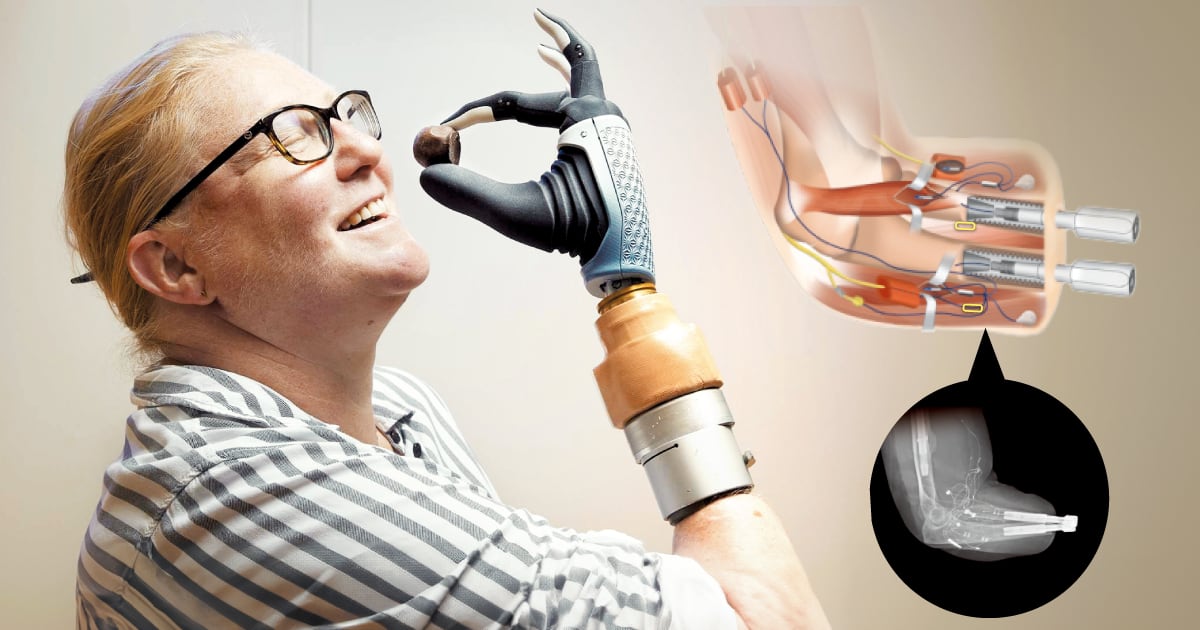Photo = Swedish Bionic Pain Research Center
Karin, a woman in her 50s living in Sweden, lost the lower part of her right elbow in an accident while working on a farm about 20 years ago. For a long time she wore prosthetics, but they did not fit her. At night she suffered from phantom pain (pain felt at the site of her amputation). She had been living in despair until her chance came to her 3 years ago. She received an offer from researchers at the Swedish Center for Bionic Pain Research, a research institute specializing in rehabilitation technology, to try out a state-of-the-art prosthetic ‘bionic hand’. A prosthetic hand was implanted into the bone of her right arm to secure it in place, and electrodes were implanted into the muscles and nerves of her right arm to connect it to the prosthetic arm, allowing her to move her fingers as desired. This is the first time that a prosthetic hand made by implanting electrodes into the body’s internal skeleton functioned normally like a real hand.
Karin’s story of gaining a new life through a prosthetic hand was made known through a research paper published in the international academic journal Science Robotics on the 11th of last month. Dr. Max Ortiscatalan of Chalmers University of Technology in Sweden, who developed the prosthetic hand, said, “Karin has recovered to the point where she can move her hand to 80% of its normal state,” and added, “She can pick up coins from the floor and put them in a glass jar or carry them in a suitcase. “I can now do most daily tasks, such as packing, without assistance,” he said. This research, which goes beyond the limitations of existing robotic prosthetics, is expected to provide hope to amputees who have lost part of their bodies due to accidents or diseases. According to the Korean Amputee Association, there are 140,000 people in Korea who suffer disabilities after losing a hand or arm in an accident, but the penetration rate of electronic prosthetic hands that work like real hands remains in the 1% range.
Graphics = Yang Jin-kyung
◇Recovery to 80% of normal level
The prosthetic hand worn by Karin used osseointegration technology, which is widely used in dental implant surgery, and technology that connects the prosthetic hand by implanting electrodes into arm muscles and nerves. Osseointegration is a technology that implants and bonds artificial objects to bone. When the implant material is bonded to the bone, bone cells grow densely around it and merge together. The researchers embedded titanium screws, which combine well with human bone and have high strength, into the patient’s lower arm (forearm) bone. Existing prosthetics shake over time and cause pain, but a prosthetic machine is attached to the bone and joined together like the body. The researchers also connected the two nerves that control movement and sensation in the hand and the prosthetic hand with electrodes. These electrodes convert nerve signals from the brain into electrical signals and transmit them to the prosthetic hand, allowing the fingers to move as the head thinks. Additionally, when grasping an object, changes in electric current that occur in the prosthetic hand are transmitted to the brain, enabling sensation.
The researchers also overcame the limitations of existing robotic prosthetic hands, whose operating performance varies depending on the degree of amputation. Robotic prosthetic hands are controlled using electrical signals and contractions of arm muscles, but if many body parts are lost in an accident and muscle mass is low, hand movements are limited. The researchers created nerve bundles by cutting the terminal ends of the nerves that control movement and sensation in the hand. Then, the nerves were extended and connected to the prosthetic hand by wrapping each nerve bundle with small muscle tissue removed from the thigh muscle. The efficiency has been improved so that more nerve signals from the brain are transmitted. In this case, the muscles remaining from the accident may be able to move the prosthetic hand, even though the muscles are relatively small.
After receiving a state-of-the-art prosthetic hand and undergoing three years of rehabilitation training, Karin no longer had difficulty in daily activities such as preparing food or zipping her clothes or bag by herself. Karin said, “Before using the prosthetic hand, I had phantom pain that felt like touching a meat grinder, but now I am free from that pain,” and added, “The dosage of painkillers has also been reduced significantly.”
◇Correction of delicate hand movements with AI
Karin’s hand movements have improved significantly since being fitted with a high-tech prosthetic hand, but there are limitations. It is difficult to move quickly and accurately like playing the piano. Researchers are also conducting additional research using artificial intelligence (AI) to implement more precise hand movements. The goal is to increase the speed of hand response by analyzing the brain’s nerve signals transmitted from various nerve bundles in the right arm using AI. When picking up an object, you can analyze the size and texture of the object or learn daily hand movement data to implement repeated movements more precisely. The researchers said, “If we add AI technology to bionic hand technology that directly connects to the user’s bones, muscles, and nerves, we will be able to create a true ‘human-machine fusion’ that can convert brain signals into accurate and simple movements.” He said.
In Korea, the development of prosthetic hand and leg technology using AI technology is also active. Last February, senior researcher Lee Kang-ho of the Korea Institute of Machinery and Materials’ Medical Machinery Research Lab developed a technology that detects loose space in the socket to which a prosthetic leg is attached in real time and fills the inside of the socket with air. The researchers explained, “The amputated area changes slightly depending on the blood circulation and skin tissue condition, and the air pressure in the prosthetic leg socket is automatically adjusted according to these changes to relieve pain in the affected area.”
2023-11-15 18:02:38
#hightech #prosthetic #hand #connected #bones #nerves #hand #picked #coins #put #bottle


